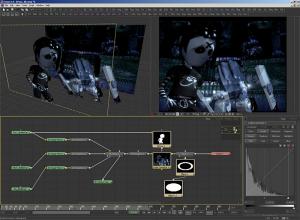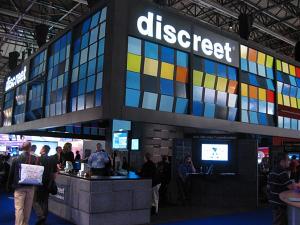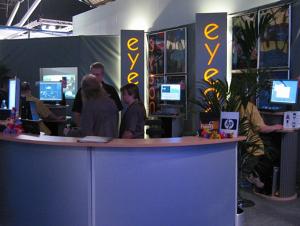I was looking forward to being far away from all the election turmoil in the states but I was hit straightaway with a reminder on the walk to my hotel. It seems here, though, there is maybe a bit more concentration on the real issues in the campaign and a bit less on the bluster. Enough said. Time to worry about such things as why espresso is so much better in Europe. And at IBC there were many interesting things to see….here’s a brief recap (in alphabet
Across the aisle in Amsterdam, Discreet was showing its new 6/9 versions of inferno, flame and flint as well as its 6.5 version of fire and smoke. The 6.5 editing version will be free for version 6 systems that are under a valid Discreet support contract on the date of release. It will be released alongside the new effects versions, bringing framestore compatibility and other interoperability between the effects and editing products.
Fxguide posted an in-depth overview of the effects products last month, so we won’t repeat that here. Features in fire/smoke which are also in the new effects release include:
- Adobe Photoshop PSD import (in the Clip Library and as a layered DVE setup)
- Soft-import and publish
- 3D LUTs
- Conform of EDLs from data sources
- GMask improvements, including motion blur and freehand shapes
- Channel Editor and Viewer improvements
The new version of fire/smoke also includes the first version of burn rendering support. It isn’t built into the timeline as shown at the NAB technology demo, so you have to save your timeline from the editdesk into the clip library and then send it to burn from inside the library. That being said, it is still great functionality to have in the product, especially for facilities that have already installed burn for their effects products. On a recent job with a tight deadline, using burn from batch totally saved the job for me — I really don’t think I could have finished the job without the ability to continue working as burn rendered away. For an overview of burn see our initial review of the product, which also includes performance benchmarks.
Lustre version 2.5 also made its European tradeshow premiere. It is getting a big acceptance at the show with its new features such as a 32-bit float processing pipeline, a much-improved workflow between primaries and secondaries, and multiple masking shapes for selectives. Lustre has found a strong following in the digital intermediate market for films, but due to workflow issues has been a hard sell in the commercial post production market.
However, according to Craig Leffel, senior colorist at Optimus in Chicago and a longtime TIG (Telecine Internet Group) poster, this is really starting to change as the product becomes more mature. The realtime broadcast output was the first step (in version 2.0), but the changes in the handling of primaries and secondaries, XYZ pan controls, and the use of the faster Nvidia 4400 card all are making it a potentially strong tool for commercial post. “Lustre looks and acts much more like a traditional color corrector now,” says Leffel, “but its so much better with all the bells and whistles of tools I never had access to before.”
Discreet also showed “stone shared”, its Discreet-branded SAN solution using the SGI® InfiniteStorage Shared Filesystem CXFS® and DataDirect Networks’ Storage Networking System. On the show floor, stone shared was connected to all discreet systems using fibre channel, allowing real time transfer of images.
From a compositing standpoint, eyeon Software’s showing of Fusion 5 is certainly one of the highlights of the show. According to Steve Roberts, founder and CEO, the internal architecture has undergone a major revision, enabling the new 3D features as well as helping improve performance on the Linux versions of their releases. A considerable amount of work was done to optimize the software. The software now requires a base-level graphics card for the interactive features, but rendering can still be done in a software-only render node environment. So in roundabout way, Halo has done wonders for the compositing world. ATI’s and Nvidia’s intense competition for the PC gaming market seems to be benefitting compositors and designers. We’re seeing more and more reliance on the GPU for image processing as Fusion and Apple’s Motion begin to take advantage of the technological advances in display cards. Even discreet’s Lustre 2.5 takes advantage of the GPUs for many activities.
The biggest change in Fusion is the addition of a 3D processing pipeline. Discreet artists have been long-accustomed to the benefits of this concept when using Action. I’ve found that when using applications without a 3D environment, it is incredibly frustrating to achieve a lot of the same results I could easily obtain in Action. I’m certain that for DF users, this will be a welcome addition. Roberts admits that at first he wasn’t certain about the benefits that this would bring, but after working with the new software for a while he became really excited about the possibilities. “I’m definitely a convert,” he states, “I can really see how it opens up a lot of new approaches.” This type of compositing becomes even more useful when coupled with 3D camera tracking….something that has become a common way of working in today’s suites.
 The 3D workflow also provided an opportunity to add a new 3D Particle Suite to the software. This node provides a variety of true 3D particle systems — bit-mapped, line, point, and geometry-based — all OpenGL accelerated through hardware. A new 3D text node also provides artists the ability to design with extruded text as well as lay it out on paths. Individual characters can also have effects applied to them. Another benefit of using hardware acceleration is essentially writing shaders that are image processing tools. Processing can quickly be done in the GPU as opposed to software-based rendering. LUTs are a great example of this…lookup tables can be done in the GPU.
The 3D workflow also provided an opportunity to add a new 3D Particle Suite to the software. This node provides a variety of true 3D particle systems — bit-mapped, line, point, and geometry-based — all OpenGL accelerated through hardware. A new 3D text node also provides artists the ability to design with extruded text as well as lay it out on paths. Individual characters can also have effects applied to them. Another benefit of using hardware acceleration is essentially writing shaders that are image processing tools. Processing can quickly be done in the GPU as opposed to software-based rendering. LUTs are a great example of this…lookup tables can be done in the GPU.
Masking is another area of improvement in Fusion 5 with a new mask node, which allows control and viewing of masks right in the flow. Double-edged masks allow for separate adjustment of inner and outer softness — very similar in nature to the advanced gradients in the Discreet products. There are also new Bspline masking tools and all masks can have motion blur applied to them.
There are also a tremendous amount of under-the hood improvements, according to Isaac Guenard, Senior Product Manager for the product. The setup files and preferences are now all ascii-text based, which allow for easy modification and integration into database-driven workflows. The files are essentially DFScript files, so it opens up a ton of possibilities for driving setups externally. There’s even more good news for DF users, since Guenard says they’re planning on fully documenting the DFScript language, as well as providing numerous examples on how to use the scripting language. There are currently some great scripting examples on the eyeon website.
eyeon was also showing a JLCooper interface to Fusion, and they plan on having the various node controls assignable to the control surface. For version 5, they are also planning on supporting the OpenFX plug-in initiative.
No firm release date has been set, but the product isn’t really expected to ship before the end of the year. Eyeon’s broadcast product DFX+ is currently on sale for $1295US. This includes a free upgrade to version 5 for any product purchased after August 18, 2004. An upgrade from DF version 4 to Fusion 5 will cost $495US.
Imagineer Systems showed their new product monet for the first time in Europe at the show. monet is a new tool leveraging the image processing technology from mokey into a product which essentially does fixes. The company has already sold 10 licenses of the software in less than a month. Purchasers include Capital FX in London and Cineimage.
Working in monet is scene-based, so you start out with the background scene which you need to have fixed. The first step is defining a four-point track area on the original frame. Monet (as seen in mokey) obviously does a nice job of creating an initial track. If the track isn’t quite on, monet offers a nice inset-split screen view of the original frame with the master tracking mark and the current frame with the tracking result. This makes it really easy to see tracker drift — easier than using a mix between the master frame and the current frame. A change which a user makes to the track at this point can be applied as a relative offset, so that a smooth transition is done between the master frame and the frame where the user moved the tracker — but keeping the needed interframe inconsistencies of the camera movement.
The replacement image is then imported into monet. This image should most likely contain a matte channel, since there are no mask creation tools within monet. Primatte is built-in, but as many artists know, a single keyer without masks is generally not enough to obtain an adequate key. The four edges of the added image area have the ability to be bent and warped in order to help integrate images into the scene. In order to further integrate the replacement image, you can then re-add (or subtract) the luminance data from the original image — useful for say re-adding the highlights from a television screen back on top of the image you’ve added.
One of those frustrating things about trying to add highlights back in is the fact that you still have tracking marks on the screen to deal with. Well, mokey has a very interesting “Marker” filter which will remove the markers and fill in the area with pixels from around the area. In the demo, it seemed to work quite well and could be a very useful feature. You simply need to use Red, Blue, or Green trackers — and then tell monet which color you used on set.
Lens distortion is another problem area for tracking objects into a scene. monet has a lens tool which helps compensate for or remove distortion. The lens tool can show on-screen lines which the software believes should be straight. The user then selects lines which are, in-fact, horizontal (the more, the better) and the software removes the distortion from the scene.
monet is currently lacking a grain/degrain tool, which is critical when doing any kind of replacement or composite. However, you can easily export a fill and matte, along with separate highlight and shadow passes to allow for more critical blending in another application.
monet is available in a software only-version for $10,00US. Later in the year, monet extreme will be shipping for GBP$15,000. The software shows a ton of promise and utility, but it will be interesting to see how well a fix-dedicated tool fits into the market. Users of Shake, DF, and flame are well versed in approaching fixes….will facilities see the usefulness in buying another software platform?
Quantel
Quantel announced an innovative new product called “Paintbox”. OK, so maybe its not so new, but it is being released on an all-new platform. Quantel has found that even with all the advancements in desktop technology as well as other dedicated systems, there is still a need in the broadcast graphics realm for super-fast broadcast still creation. It features the familiar interface (with improvements from their recent products) and is available in hardware-supported versions for HD and SD. They also introduced QPaintbox — a version which is a software-only release.
Quantel also showed a preview version of the next release of iQ and eQ, which will be available in early 2005. Features which are being added or improved include Warp, Motion Blur, Modify Keyframes All, Layer Blend Modes, and new keyers. The dedicated hardware of the Q products has always made for some impressive benchmarks and responsiveness….with the addition of more and more features for artists they are working their way up to other products and leaving their “dark years” of development behind. But it still seems as though they have some catching up to do in order to catch the other compositing packages which are available.
SpeedSix
SpeedSix, makers of the Monsters suite of sparks and plugins, was showing their first Raptor application called Speedo. Speedo is a speed change application which uses motion estimation technology. Raptors differ from Monsters in the fact that they are considered individual applications and not plugins. At the base entry level ($1000US), Speedo provides local rendering as a spark which runs on discreet (flame and fire) workstations or a plugin for eyeon’s Digital Fusion or AvidDS. For $1000US more, facilities can get SpeedoMax which provides a network manager and unlimited rendering licenses on Windows (2000 and XP), Redhat Linux, and IRIX machines — all cued from the FFI or DF workstation and managed through a web interface.
On the IBC show floor, SpeedSix was demoing Speedo on a discreet effects system. Work on flame/fire is done through the standard sparks UI. Artists first start by loading the clip they want to effect into the spark. Next, pick a constant rate (percentage, frames per second, or output length) or create a varispeed using the channel editor. There are handles for fine-tuning the Speedo algorithms, including vector length, number of processing iterations, and stages. Motion blur can also be added to the processed output. For the initial release, motion vectors are not editable and there is no ability to help Speedo’s algorithm through the use of guiding masks or mattes.
For the final render, instead of tying up the artist workstation for the computationally-intensive process, SpeedoMax users can submit their jobs for network rendering. The spark saves the images to a mounted filesystem and then sends the job to the Speedo Flow Manager. The manager then sends the job to any machine on the network which has Speedo installed. This could be a render farm or a group of individual machines on the network. Management of the network and monitoring of the rendering queue is done through a web browser interface, accessible from any machine on the LAN. Once the rendering is done, the FFI/DF user can load the finished clip back into the system (from within the spark UI).
It is really an interesting workflow, as anyone who has attempted motion estimation speed changes with high resolution imagery. The idea of having unlimited network rendering is quite appealing. As to the quality of the result, it is really hard to tell in staged demos on the show floor but the results certainly do look good. In the coming months, fxguide is planning on doing a motion estimation shootout with the various manufacturers of speed change plugins.



